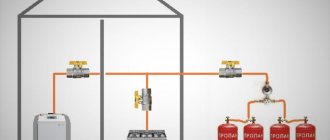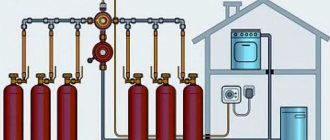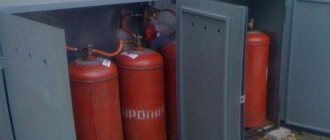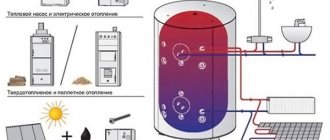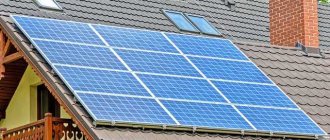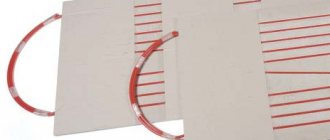It’s easy to calculate how much money is spent on electricity in an apartment. You go to the meter and look - and so on every month. What's in the apartment? Washing machine, TV, computer and a dozen light bulbs.
A completely different story is a private house. It is sometimes impossible to understand where such a figure comes from in a month, even for those who live in the house.
What if you are still a city dweller? If you still have plans to build a private house, and you are afraid that you will not be able to maintain it?
This is where our top-down calculations will help you - where the electricity goes in a private home.
Consumption calculation
What kind of electricity consumption an electric boiler has can be found out if you take into account the generally accepted rules:
- Firstly, to heat one cubic meter with a heat generator, you need (let’s take the average value) 4-8 Wh of electrical energy consumption. The exact figure depends on the results of calculating the heat losses of the entire building and the specific value during heating. Calculations are made using an indicator that takes into account additional heat loss through parts of the walls of the building, through pipelines running in rooms without heating.
- Secondly, when calculating how much electricity an electric boiler consumes, they use the duration of seasonal heating (seven calendar months).
- Thirdly, if you want to find out the average power indicator, use the following provision. To provide heat to an area of 10 m² with structures with excellent insulation, up to three meters in height, 1 kW is enough. It turns out, for example, to heat an area of 180 m², the power of an 18 kW unit will be sufficient. Be aware that if a boiler is selected with insufficient power characteristics, then a favorable microclimate will not be achieved. If the boiler power is too much for a given room, then excess energy consumption will occur.
- In order to find out how much electricity an electric boiler consumes per month, serving an average building, you will need to multiply the power of the unit by the number of hours of its operation per day (continuous operation).
- The data obtained is divided by two. It is worth remembering that a constant maximum load for all seven months is not typical for the boiler (i.e., thaw periods, a decrease in heating temperature at night, etc. are excluded). Thus, we get a result showing how much an electric heating boiler consumes per month. This is an average indicator of the amount of energy.
- If we multiply this figure by the seasonal heating time, i.e. seven months, then you get the total electricity consumption for a year of heating.
Taking into account the price per unit of power, the total needs for heating the house are calculated.
Formula for thermal engineering calculation of power W = S x W beats /10 W beats /10 - specific power per 10 m²; S is the area of the heating space, m².
Single-story frame 9*13 at SVF in Matoksa ~110m2
The house was built in 2015, the insulation of the walls is 150 mm, the insulation of the floor (pile-screw foundation) and ceiling is 200 mm, the ceilings are 2.7 m.
Heating: electric convectors, 1 pc. 2 kW, 4 pcs. 1 kW each, 4 pcs. 1.5 kW each. IR floors in all rooms; Mode of operation of the house: seasonal, with visits on weekends, temperature 20-21, in absence 8-10; The average bill for heating in winter: electricity ~4000 rubles/month, in January 2022 it was around 5000 (customers spent all holidays at the dacha, the rest of the time they maintained +10), the electricity tariff was 4.08 rubles per day, 2 per night, 08 rub.
You can read about the house using the tag “framework near Matoksa”.
Calculation of the power of heating devices
Before calculating the power of a heating boiler, you should determine what type of boiler will be used. Heating boilers have different efficiencies and not only the level of heat transfer will depend on this choice, but also the financial component of subsequent operation when choosing fuel:
- Electric boilers,
- Gas boilers,
- Solid fuel boilers,
- Liquid fuel boilers,
- Combined electric/solid fuel boiler.
When the choice of boiler type is made, it is necessary to determine its throughput. The functioning of the entire system will depend on this. The power of a water heating boiler is calculated taking into account the amount of heat energy required per m3. The calculator can help calculate the volume of heated rooms:
- bedroom: 9 m2 3 m = 27 m3,
- bedroom: 12 m2 3 m = 36 m3,
- bedroom: 15 m2 3 m = 45 m3,
- living room: 25 m2 3 m = 75 m3,
- corridor: 6 m2 3 m = 18 m3,
- kitchen: 12 m2 3 m = 36 m3,
- bathroom: 8 m2 3 m = 24 m3.
When calculating, all rooms of the house are taken into account, even if it is not planned to install radiators in them. Source stroikairemont.com
Next, the results are summed up, and the total volume of the house is obtained - 261 m3. When calculating, be sure to take into account rooms and passages in which it is not planned to install heating devices, for example, a corridor, pantry, or hallway. This is done so that the heat from the radiators installed in the house is enough to heat the entire house.
Let's take an arbitrary indicator for the region of 50 W/m3 and a house area of 261 m3, which is planned to be heated. Power calculation formula: 50 W 261 m3 = 13050 W. The result is multiplied by a factor of 1.2 and the boiler power is calculated - 15.6 kW. The coefficient allows you to add 20% of reserve power to the boiler. It will enable the boiler to operate in a saving mode, avoiding special overloads.
Additional temperature sensors will help control the processSource dopebi.ru.net
The correction of the coefficient for the climatic conditions of the regions varies from 0.7 in the southern regions of Russia to 2.0 in the northern regions. A coefficient of 1.2 is used in the central part of Russia.
Here is another formula that online calculators use:
To get a preliminary result of the required boiler power, you can multiply the area of the room by the climate coefficient and divide the resulting result by 10.
An example of a formula for calculating the power of a heating boiler for a house with an area of 120 m2 in the northern region of Russia:
Nk=120*2.0/10=24 kW
Calculation of maximum heat loss of a building
Let's calculate the approximate heat losses of the building at -30 degrees to determine the maximum power of our system:
- Q windows = 3.6 x (20-(-30)/0.4 = 450 W
- Q walls = 104.4 x (20-(-30)/5.17 = 1009 W
- Q roof = 100 x (20-(-30)/5.17=967 W
Heat loss through the floor, located directly on the ground, is calculated by zone. To do this, the floor surface is divided into strips 2 m wide, parallel to the outer walls. The strip closest to the outer wall is designated the first zone, the next two strips are the second and third, and the rest of the floor surface is the fourth zone. The floor surface in the zone adjacent to the outer corner of the room has increased heat loss, so its area at the junction is taken into account twice when determining the total area of the zone. The heat loss of each zone is calculated using the formula:
Rzones = Rservice + Rfloors
The value of Rusl is taken as the conditional heat transfer resistance of an uninsulated floor: for the first zone - 2.1; for the second zone - 4.3; for the third zone - 8.6; for the fourth zone - 14.2.
We get:
- S zone1 = 80; R zone1 = 2.1 + 2.85 = 4.95
- S zone2 = 48; R zone2 = 4.3 + 2.85 = 7.15
- S zone3 = 4; R zone3 = 8.6 + 2.85 = 11.45
- Floor Q = Zone1 Q + Zone2 Q + Zone3 Q = 80 x (20-(-30)/4.95)+48 x (20-(-30)/7.15)+ 4 x (20-(-30) )/ 11.45)=1160 W
- Q total = 1160 + 967 + 1009 + 450 = 3586 W
The total rated power of the system required to heat the room at -30 degrees is 3.5 kW.
How much gas/electricity does the boiler consume?
The easiest way to measure the amount of gas consumed by boilers per hour is to multiply the boiler power by 0.12 cubic meters. This figure is necessary to create and maintain heat of 1 kW. A 10-kilowatt boiler consumes 1.2 cubic meters, for example. If consumption has to be calculated by day, then other formulas and input data will have to be used.
If the burner does not operate for a full day (not 24 hours), then the idle period and the operating period are equal to 50%. Consumption time – 12 hours. Then, daily consumption will have to be increased by 12.
To calculate the boiler's gas consumption per month, you need to multiply the consumption per day by days per month (28/29 or 30/31, usually the average value is 30). For example, a 10 kilowatt boiler will consume 432 cubic meters.
Let's look at the types of gas boilers
- Automation. In boilers that consume gas, specific automation and timers are installed that allow you to control the device. Thanks to this automation system, you can use the boiler as comfortably and efficiently as possible and control fuel consumption
- Condensing boiler. This type of gas boiler is one of the most economical, since its gas consumption is several times less. Such a boiler uses heat energy, which is generated due to the condensation of vapor from water (hence the name). This unit perfectly warms the room, and thanks to its well-designed design, you can economically use all available functionality. The principle of operation is quite simple. The water is heated by the gas and then heated by a gas burner. This type of boiler is more expensive than standard ones, but it saves the lion’s share of fuel.
It is extremely rare to find gas boilers in apartments. This is due to the fact that the installation of such a unit is quite complex and time-consuming. However, sometimes such a boiler is simply necessary.
In this case, you will have to take care of many factors to reduce gas consumption:
- The façade needs to be well insulated. This is a necessary measure to reduce consumption.
- Carefully study the characteristics of the boilers. Choose the option that will be the most economical.
- In order not to “heat the street”, you should take care of installing plastic windows with double or triple glazing.
With good insulation of the apartment, fuel consumption can be reduced by more than 50%.
More often, boilers are found in private homes or premises. In this case, it can be connected to the heating system or swimming pool.
However, to save gas you have to follow some rules even in a private home:
- Install the counter. It is not always possible to independently control the fuel consumption in the boiler, so you can install a meter that will record the consumption. Initially, the readings will seem very conditional, since fuel consumption in a private home directly depends on weather conditions. After a year, you will be able to make the most accurate calculations about fuel economy. If you see that the consumption is too high, you will have to take care of insulating the room.
- Insulate the room. Try to seal as much as possible any openings in the walls that open to the outside. Spend a lot of your time on insulating the attic, roof, any technical premises, cellar, veranda. In short, you need to take care of insulating the most “vulnerable” places in the house - the places that release heat.
Let's consider one of the options for installing a gas boiler in a private house:
- “Warm floor” with a built-in cast iron heat exchanger with efficient settings and suitable power.
- The boiler should be installed with indirect heating and a sufficient amount of water in the tank.
- Install the programmer and thermostats. This will help keep all equipment under control depending on the schedule and time of day.
Take the time to study the list of main reasons affecting fuel consumption. This often depends on the power of the equipment. Do not under any circumstances think that you can reduce fuel consumption by using incomplete functionality. This is wrong!
Before calculating costs, you first need to determine the needs of the heating system that you have installed.
To do this, you don’t need to be a great mathematician or know all the most complex formulas. Let's use the simplest proportion:
10 sq.m = 1 kW. During frosty periods, add about 15-25%, that is, about 1.2 kW.
Let's look at how this is used in practice:
- We calculate the exact area of the rooms with the heating system supplied. Corridors and technical rooms are also worth considering.
- Divide the resulting number by 10 and multiply by 1.2. This is the maximum possible energy consumption of the heating system. Divide the resulting figure by 10 and multiply by 1.2. We round the figure to the closest to the power of the devices and we get the most profitable option for us.
What electrical requirements should you pay attention to?
Before connecting the electric boiler, you need to pay attention to the electrical requirements
- How many watts of voltage can your home's current network handle? In particular, the voltage in rural areas is not 210-230 V, but only 150-180 V. Specific types of imported boilers at this voltage may simply not start.
- What power is allocated to your series of houses or to the village in which you live. For example, if your dacha community includes 60 houses, and electricity is allocated at the rate of 5 kW per house, then in the process of installing a boiler with a power of 30 kW you will certainly have disagreements with your neighbors. How much power is allocated to your home? Modern dacha communities very often install a 10-12 kW automatic machine in order to avoid quarrels with their neighbors.
- It is worth checking the current condition of the transformer installed in your village. In some cases, it is necessary to pull certain wires to connect the electric boiler.
- Find out what powerful electrical appliances your neighbors have installed and whether their total power will drop below that allocated for the house.
If all requirements are met, you can install an electric boiler or convector.
The energy consumption to ensure heating of 1 m 3 of volume is used by an electric boiler and a convector approximately equal. Date: September 25, 2022
Heating costs with a heat pump with a two-tariff meter.
When metered with a two-tariff meter, the price of 1 kilowatt of electricity from 7-00 to 23-00 is 2 rubles. 72 kopecks, and from 23-00 to 7-00 - 92 kopecks. With a heat pump COP of 3, these figures will be 91 kopecks, respectively. and 30.6 kopecks. Thus, the cost of heating our house will be:
150*5*(13*0.91+11*0.306) = 12756 rubles. In reality, taking into account the fact that heat loss at home increases at night, this figure will be slightly lower.
With COP = 5, we obtain the following arithmetic: The cost of heat at the daytime tariff is 0.544 kopecks, at night - 18.4 kopecks. In total, heating costs during the heating season will be:
150*5(16*0.544+8*0.184) = 7632 rubles.
For solid fuel boilers
Diagram of a heating system with forced circulation.
One of the common methods of heating for country houses is solid fuel boilers, for which ordinary firewood is used as fuel. Don’t think that stoves are a thing of the distant past; their modern models are quite popular today; they allow you not only to organize heating for your home, but also to ensure an uninterrupted supply of hot water. Many of them have a stove designed for cooking.
To calculate home heating costs, consider:
- the cost of one cubic meter of firewood, today it is approximately two thousand rubles when taking into account delivery by your own transport;
- there are 650 kg in one cubic meter, that is, the cost of one kilogram is: 2000/650 = 3.08, we round the resulting value and find that the price of a kilogram is approximately three rubles;
- to get 1 kilowatt of heat you need to use 0.4 kg of firewood, that is: 3*0.4=1.2. To obtain one kilowatt of heat, the monetary equivalent is 1.2 rubles.
Estimation of the required volume of energy carrier
Many cottages were built according to individual projects using building materials, thermal insulation, and finishing that varied in structure and thermal technology. In addition, winter climatic parameters for different regions can vary greatly. Therefore, there may be significant differences in calculations of the volume of energy that will be needed to heat a house.
Calculation of the required amount of heat
Heating is designed to compensate for the heat loss of the building, which occurs for two reasons:
- energy loss due to freezing of the perimeter of the house;
- replacement of warm air with cold air during ventilation.
In order to understand whether it is more profitable to heat a private house - gas or electricity, it is not necessary to carry out highly accurate calculations. An approximate estimate (± 20%) of the volume of heat loss during the winter period is sufficient to determine the difference in the final cost of the energy carrier.
Insulating a country house is a great way to save on heating costs. This will not reduce capital investment, but will reduce annual payments for gas or electricity
There are two options according to which it is possible to determine the amount of heat loss with acceptable accuracy:
- Order a calculation of this parameter from heating engineers. In this case, to save money, it should be mentioned that calculations can be carried out using a simplified method.
- Carry out calculations yourself, knowing such parameters as heat transfer resistance coefficients of house materials, perimeter and roof area, ventilation volume, temperature difference, etc.
The obtained heat loss results must be converted to a standard unit of measurement - W.
Electricity and gas consumption
Instead of calculating heat loss, you can use the analogy method
If nearby (the coincidence of climatic conditions is very important) there is a building similar in geometry and material, then you can find out the volume of gas or electricity consumed from the meter readings
In this case we have three options:
- the heat loss of the building is known;
- there is data on the volume of gas consumed at a similar facility;
- the amount of electricity spent on heating is known.
It is necessary to find out the volume of electricity and gas consumption during the winter period.
If the boiler also provides hot water, then additional electricity or gas consumption will need to be taken into account in the calculations
First of all, you need to determine the duration of the heating period E (hour). This can be done according to column No. 11, table No. 1 of SNiP 01/23/99. To do this, you need to select the nearest town and multiply the number of days by 24 hours.
Since the calculations allow for minor approximations, we set the following constants:
- The efficiency of the electric boiler is 98%;
- The efficiency of the gas boiler is 92%;
- the calorific value of natural gas is 9.3 kW × h / m3;
- The calorific value of liquefied gas is 12.6 kW × h / kg.
In this case, the basic conversion formulas will have the following form:
- The volume of consumed natural gas V (m3) is known. Heat loss of the building: Q = V × (9300 × 0.92) / E.
- The mass of consumed liquefied gas V (kg) is known. Here, for a propane-butane mixture, you can use the ratio 1 kg = 1.66 liters. Heat loss of the building: Q = V × (12600 × 0.92) / E.
- The amount of consumed electricity V (W × h) is known. Heat loss of the building: Q = V × 0.98 / E.
- The building's heat loss Q is known. The required volume of natural gas is: V = Q × E / (9300 × 0.92).
- The heat loss of the building Q is known. The required volume of liquefied gas: V = Q × E / (12600 × 0.92).
- The building's heat loss Q is known. The required amount of electricity is: V = Q × E / 0.98.
Calculating the heat loss of a building has another purpose - it can be used to calculate the maximum consumption of electricity and gas during the coldest five-day period of the season. This will help you choose the right boiler power and avoid problems with overload.
During extreme cold weather, electricity consumption increases sharply, which can lead to failures. Therefore, you need to have backup power or use thermal accumulatorsWhen comparing the cost of gas and electric heating, the autonomous power supply system does not need to be taken into account, since in extreme frosts it can be used with any type of fuel.
We calculate the consumption of an electric boiler
You can find out complete information on the selection, operation and maintenance of gas boilers from all manufacturers if you go.
One of the decisive questions in choosing this device is how much it will cost to heat a house with an electric boiler. After all, you can save on the cost of the device itself, and then pay huge bills. To prevent this from happening, consider the following table.
Difference in consumption of ion and heating element boilers.
We will give an example for an inverter and induction boiler, the area of the heating room is a house of 240 m2, with a standard ceiling height of 3 m, where there are good plastic windows, doors with good thermal insulation, the house itself is insulated.
And then, we will give a more specific example with numbers on how to calculate the consumption of an electric boiler, provided that your entire system is connected, the batteries are installed, in general, everything is ready for use. And let’s try to figure out whether a heating element electric boiler or an induction one is beneficial.
Initial data:
Duration of operation is 10 hours, during the day it was heated to the set temperature and turned off. To begin with, we will calculate the invert one, and also take into account the fact that over time its efficiency decreases significantly.
The first year of heating will be the most efficient and least expensive. 24 (power)*10 (operating time)*30 (days per month)*7.2 (cost of electricity) = 19,450 rubles per month or 136 thousand rubles for 222 days.
In the 2nd year, energy consumption will increase by an average of 15%, the heating duration will increase by an hour and a half and, based on these data, the monthly amount is 22,400 rubles, and for the heating season you will have to pay 156,500 rubles for electricity.
In the 3rd operational year, the heating element “wears out” even more and losses will be up to 18%, and the operating time will increase by three hours compared to the first year. The energy consumption will be 24 kW, and the energy output will be 16 kW. However, with proper care, timely cleaning and necessary operational measures, these indicators can increase with less intensity.
Next, let's look at an example in numbers with an induction double-circuit boiler. All data is the same as in the first case. 20 (power)*240 (room area)*30 (calendar month)*2.7 (tariff)*10 (operation duration)=16,200 rub. per month, and for the entire season 113,402 rubles.
An undoubted advantage is the fact that the amount will remain unchanged in subsequent years, provided that the established tariff does not change and electricity consumption remains constant, unlike the first example. The efficiency does not decrease after the service life expires, since there is no scale formation.
If you were in doubt before, then from the calculations it becomes obvious that this boiler is more profitable.
Well, for comparison, let’s give an example of how much electricity a gas boiler consumes. To operate the pump, it needs 60 W, during ignition it consumes about 120 W, and if there is a closed combustion chamber for the fan to operate, another plus 30 W. In total, by adding up all the needs of a particular unit, you will get the total amount of energy consumption for gas equipment.
Selection of heating radiators
Traditionally, it is recommended to select the power of a heating radiator according to the area of the heated room, with a 15-20% overestimation of power requirements, just in case.
Using an example, let’s look at how correct the methodology for choosing a radiator is “10 m2 area - 1.2 kW”.
The thermal power of radiators depends on the method of their connection, which must be taken into account when calculating the heating system
Initial data: corner room on the first level of a two-story individual housing construction building; external wall made of double-row ceramic bricks; room width 3 m, length 4 m, ceiling height 3 m.
Using a simplified selection scheme, it is proposed to calculate the area of the room, we consider:
3 (width) 4 (length) = 12 m2
Those. the required power of the heating radiator with a 20% increase is 14.4 kW. Now let’s calculate the power parameters of the heating radiator based on the heat loss of the room.
In fact, the area of the room affects the loss of thermal energy less than the area of its walls, facing one side outside the building (facade).
Therefore, we will calculate exactly the area of the “street” walls present in the room:
3 (width) 3 (height) + 4 (length) 3 (height) = 21 m2
Knowing the area of the walls that transfer heat “to the street,” we will calculate the heat loss for a difference in room and street temperatures of 30° (in the house +18°C, outside -12°C), and immediately in kilowatt-hours:
0.91 21 30: 1000 = 0.57 kW,
Where: 0.91 - heat transfer resistance m2 of room walls facing “outside”; 21 - area of “street” walls; 30 - temperature difference inside and outside the house; 1000 is the number of watts in a kilowatt.
According to building standards, heating devices are located in areas of maximum heat loss. For example, radiators are installed under window openings, heat guns are installed above the entrance to the house. In corner rooms, batteries are installed on blank walls exposed to maximum exposure to winds.
It turns out that to compensate for heat loss through the facade walls of this structure, with a 30° temperature difference in the house and outside, heating with a capacity of 0.57 kWh is sufficient. Let's increase the required power by 20, even 30% - we get 0.74 kWh.
Thus, real heating power requirements may be significantly lower than the trading scheme “1.2 kW per square meter of room area.”
Moreover, correct calculation of the required power of heating radiators will reduce the volume of coolant in the heating system, which will reduce the load on the boiler and fuel costs.
Calculation of heating costs
It is generally accepted that for heating 10 sq. m of insulated living space, you will need a 1 kW boiler.
To analyze the costs of autonomous heating in a country house, we will set the same conditions:
- heating season – 7 months;
- the boiler operates half the total time;
- area of a country house – 150 sq.m.;
- boiler with a capacity of 15 kW.
Example calculations for some types of fuel:
Main gas boiler. Let's calculate how much thermal energy is spent on heating such country houses per month:
- A 15 kW boiler consumes approximately 1.72 m³/hour of main gas.
- The average tariff for natural blue fuel is 5.27 rubles.
- This means that for one hour the cost of heating is 1.72 m³/hour * 5.27 = 9.06 rubles.
- During the day, a boiler operating half the total time, that is, 12 hours, spends gas in the amount of 9.06 * 12 = 108.77 rubles.
- For a month - 108.77 * 30 = 3,263 rubles.
- For 7 months – 3,263 * 7 = 22,842 rubles.
So, calculations showed that the seasonal cost of heating a country house with main gas will be about 23,000 rubles.
LPG boiler. Combustible propane-butane mixture:
- To generate 1 kW of thermal energy, about 0.12 liters will be required. (0.00012 m³) liquefied gas.
- 15 (boiler power) * 0.12 (fuel consumption per 1 kW of energy) * 12 (operating hours per day) * 24 rubles/liter = 518.4 rubles/day.
- 518.4 * 30 = 15,540 rubles per month.
- 15,540 * 7 = 108,780 rubles per season.
Conclusion: a very expensive heating method.
Solid fuel boilers. Not the most economical option.
- On average, 1 m3 of firewood costs 2,000 rubles.
- A 15 kW device burns approximately 0.15 cubic meters per day (12 hours),
- 2,000 * 0.15 = 300 rubles per day.
- 300 * 30 = 9,000 rubles per month.
- 9,000 * 7 = 63,000 rubles per season.
As a result, the cost of thermal energy for heating a house during the season when burning wood is 63,000 rubles.
Electric boiler. The calculations here are very simple:
- The device consumes 15 kW of electricity per hour.
- When operating 12 hours a day, 15 * 12 = 180 kW per day.
- 180 * 5.47 (price for electricity) = 984.6 rubles per day.
- 984.6 * 30 = 29,538 rubles per month.
- 29,538 * 7 = 206,766 rubles per season.
Conclusion: the most expensive way to heat a cottage with an area of 150 sq.m.
Cost of thermal units using electricity
If you do not consider electric boilers with different configurations, their prices do not vary much.
With an average boiler power for your area of 16-18 kW, the cost will be from 15,000 to 25,000 rubles.
You can save a lot of money by buying a heat generator not at the end of the construction season, when everyone wants to start the CO as soon as possible, but at the very beginning.
After all, you’ve already done power calculations, haven’t you? It's time to buy an electric boiler at a discount.
House heating cost table
So here's the pivot table. In addition to the cost of 1 kW, the estimated cost of equipment without installation has been added.
| Type of fuel | kW/h, rubles | Equipment costs, 20 kW, rubles |
| Boiler room using liquefied gas | 2,65 | 40 000 +200 000 |
| Diesel boiler room | 4,01 | 65 000 + 20 000 |
| Boiler room on a pallet boiler | 1,87 | 180 000 |
| Solid fuel boiler using birch wood | 1,13 | 40 000 |
| Boiler room on an electric boiler (single tariff metering) 2022 | 4,04 | 30 000 |
| Boiler room on an electric boiler with a buffer tank (night tariff) 2017 | 1,26 | 30 000 + 90 000 |
| Heat pump | 1,12 | 450 000 |
| Natural gas boiler room | 0,43 | 40 000 + 350 000 |
Let us explain what concerns the liquefied fuel boiler room: the cost of 1 kW, which we calculated, plus the cost of a gas boiler and plus the average cost of a gas holder without installation, of course.
Diesel boiler room: the cost of 1 kW is 4.01, the cost of a diesel boiler with a burner is 65,000 rubles, and the cost of a fuel tank is 20,000 rubles.
Boiler room on a pallet boiler: the average cost of a boiler on pallets is 180,000 rubles.
The average cost of a solid fuel boiler is 40,000 rubles.
The cost of an electric boiler is 30,000 rubles.
In the example with an electric boiler, we indicate the cost of the boiler equal to 30,000 rubles and plus the cost of the buffer tank equal to 90,000 rubles.
The cost of a heat pump with equipment will cost approximately 450,000 rubles.
Perhaps in your region it will all be much cheaper.
Boiler on pallets
Let's look at the costs of heating a house with a boiler room with a boiler on pallets. The calorific value of 1 kg pallet is 4.8 kW/h.
The efficiency of a pallet boiler is 0.87, that is, about 87%. The cost of 1 kg of light pallets for Moscow is approximately 7.80 rubles.
We calculate, accordingly, the cost of 1 kW/h of heat from a pallet boiler - 1.87 rubles.
Solid fuel boiler using birch wood
Then let's look at a solid fuel boiler using birch wood. The calorific value of 1 kg of firewood is 4.2 kW/h.
The efficiency of a solid fuel boiler is 0.7. This figure of 70% is the lowest of all possible heat sources discussed in the article.
The cost of 1 kg of firewood is approximately 3.33 rubles. We find that the cost of 1 kW/h of heat from a solid fuel boiler is 1.13 rubles.
Why is all this needed?
The problem should be considered from two points of view - from the point of view of apartment buildings and private ones. Let's start with the first ones.
Apartment buildings
There is nothing complicated here: gigacalories are used in thermal calculations. And if you know how much thermal energy remains in the house, then you can present the consumer with a specific bill. Let's give a small comparison: if centralized heating operates in the absence of a meter, then you have to pay according to the area of the heated room. If there is a heat meter, this in itself implies a horizontal wiring type (either collector or serial): two risers are brought into the apartment (for “return” and supply), and the intra-apartment system (more precisely, its configuration) is determined by the residents. This kind of scheme is used in new buildings, thanks to which people regulate the consumption of thermal energy, making a choice between savings and comfort.
Let's find out how this adjustment is carried out.
1. Installation of a general thermostat on the return line. In this case, the flow rate of the working fluid is determined by the temperature inside the apartment: if it decreases, the flow rate will accordingly increase, and if it increases, it will decrease.
2. Throttling of heating radiators. Thanks to the throttle, the passage of the heating device is limited, the temperature decreases, and therefore the consumption of thermal energy is reduced.
Private houses
We continue to talk about calculating Gcal for heating. Owners of country houses are interested, first of all, in the cost of a gigacalorie of thermal energy obtained from one or another type of fuel. The table below may help with this.
Table. Comparison of cost of 1 Gcal (including transport costs)
* - prices are approximate, since tariffs may differ depending on the region, moreover, they are constantly growing.
How to properly organize an alternative heating system?
The first thing you need to do is draw up a project. Heating with electricity, an economical method, cannot be organized without drawing up a normal diagram. There is no need to draw up a project only if you need to heat a room with a very small area. In this case, the issue of organizing a heating system can be solved using simple blowers or convectors with low power. In a normal private or country house, it is impossible to fully use such heating devices and it will not be possible to organize an economical electric heating system without drawing up design documentation.
Heating scheme for a private house
At the same stage, the choice of the necessary heating equipment should be determined. This equipment will largely determine how economical the heating system and all economical electric heating will be.
Other heat sources
To assess how costly heating with electricity is, it is necessary to compare it with other energy sources. It should be taken into account that the efficiency of fuel boilers is far below a hundred: for gas boilers it is about 93%, for wood and coal boilers it is about 85%.
Below is the cost per 1 kWh for different types of fuel:
- Natural gas: 0.68 rubles, taking into account efficiency - 0.75 rubles.
- Oak firewood: 1.09 and 1.36 rubles, respectively.
- Coal: 1.33 and 1.57 rubles.
- Wood pellets: 1.51 and 1.78 rubles.
- Liquefied gas: 1.99 and 2.13 rubles.
- Diesel fuel: 3.51 and 3.90 rubles.
In each case, heating costs for the season will be (for 17,388 kWh):
- natural gas: RUB 13,041;
- oak firewood: RUB 23,648;
- coal: RUB 27,300;
- wood pellets: RUB 30,950;
- liquefied gas: RUB 37,036;
- diesel fuel: RUB 67,813.
The average price level is given.
Costs with an electric boiler
Now let's look at the capabilities of the electric boiler. In this case, you need to understand whether the allocated power limit is enough for you? Secondly, two-tariff electricity metering is already implemented almost everywhere.
Let's look at two options: single-tariff and two-tariff.
Single tariff option
Accordingly, the cost of 1 kW/h of heat from an electric boiler is 4.04 rubles. In this case, savings can be achieved by using automation so as not to overheat the room needlessly.
Two-tariff option
In the two-tariff version, together with an electric boiler, a storage tank of the appropriate volume is installed. In this case, the boiler mainly operates at night, at maximum power, at the night tariff.
It heats the room, and excess heat goes into the storage tank. Then, during the day, the room is heated using the heat accumulated at night at the night tariff.
Sometimes this heat is not enough and the boiler does not heat the house, sometimes this heat is produced in excess, so we take into account that heating occurs only at the night rate. The cost of 1 kW/h of electricity in the Moscow region for 2022 (at night tariff) is 1.26 rubles
The cost of 1 kW/h of electricity in the Moscow region for 2022 (at night tariff) is 1.26 rubles.
The efficiency of an electric boiler is 1. In this case, the cost of 1 kW/h of heat from an electric boiler is 1.26 rubles.
That is, the cost will be a similar figure to the cost of electricity at the night tariff and will be equal to 1.26 rubles.
Tariffs and final cost calculation
Knowing the volume of energy consumed and its cost, you can simply multiply to calculate heating costs. This is true for gas, but for electricity there are some nuances.
In rural settlements, as well as city apartments or private houses not connected to gas, there is a reduction in payment for electricity. To confirm the right to use a preferential tariff, you must provide a package of documents to the organization providing electricity supply.
If gas is supplied to the house, but the owner does not want to use it, then this will not be a basis for applying a reduction factor
There is also another way to reduce electricity bills - switch to a tariff differentiated by time of day. To do this, you need to apply to the sales company and purchase a multi-tariff meter.
In order for the boiler to work only at night, you will have to organize a special battery for the coolant. It is a well-insulated container of large capacity. This also requires some investment.
